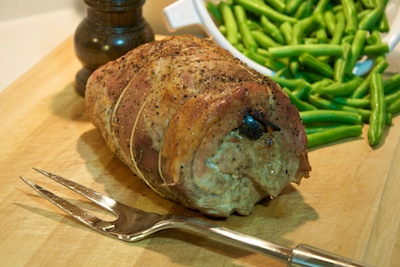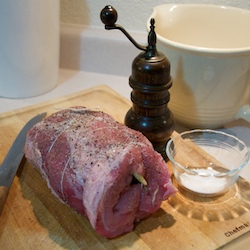
Pork is an excellent and tasty meat, but are you looking for something other than the same, ordinary pork chop for another Sunday dinner? Or perhaps you might be interested in pork you can proudly serve to company. This Norwegian recipe is an excellent choice for a tender, juicy, and succulent pork loin roast. Apples are always an excellent accompaniment to pork, and here they are used as a stuffing for the roast. The apples and prunes provide a good counterpoint in flavor and texture, and help keep the roast juicy. It’s also a great combination for the flavors of the autumn season.
Ideally, the roast would be stuffed by creating a beautiful spiral of layers of pork and fruit. It is not difficult to “unroll” the whole boneless pork loin. Just proceed carefully with shallow cuts as described below, and the roast will unroll and flatten out very easily for you. Once filled and re-rolled, the result will be an impressive presentation. It will also evenly distribute the fruit for peak flavor and moistness.
If you are not familiar with the procedure for tying a roast such as this, you might consider viewing the Good Eats episode titled “Fit to Be Tied.” Alton Brown is making a beef roulade in that episode, and describes a procedure for tying the rolled flank steak he is using. I would have been lost when it came to tying the roast had it not been for this episode. (You can see it on YouTube. The tying procedure is demonstrated in the last couple of minutes of part 1 and the first minute or so of part 2.)
Apple-Stuffed Pork Loin
- 1 boneless pork loin roast (3-6 pounds)
- 1 green apple
- 10 pitted prunes
- 1 tablespoon salt
- 1 teaspoon freshly ground black pepper
- 3 cups chicken broth
- Preheat oven to 350° F.
- Peel, core, and slice apples into ¼ inch slices.
- If roast is on solid piece of meat (which would be preferred) carefully trim the roast to “unroll” it into a single slab about ½ inch thick. Do this by starting to cut along the long axis and cut with successive shallow cuts approximately ½ inch from the roast’s current surface. (Please see photos of the cooked and sliced roast below as a guide.) Lay out flat with the outside of the roast against your work surface.
- Arrange the apple slices in a layer over the roast along with the prunes. Sprinkle with 1 teaspoon of salt and ½ teaspoon of pepper. Tightly roll the roast to make a spiral of pork and filling. (Hint: An easy way to do this, without the hassle of the fruit being pushed out of the way as you roll, is to do this in stages. Cover the inner third of the flattened roast with half of the fruit and season. Fold the remaining two-thirds of the meat over the fruit. Turn the roast over, and arrange the remaining fruit on the still flat portion of the roast. Fold the roast’s core over the fruit. This will return the roast to close to its original shape and create the desired spiral effect with little difficulty.)
 Tie the roast to keep it tightly rolled. Using a good length of kitchen twine or string, tightly tie around the roast near one end. Create two or three loops and position them along the length of the roast, pulling tight. From the final loop, bring the string around the end of the roast and down the length of the underside. You may wish to tuck it into one or two of your loops. Bring the twine back over to the top of the roast and secure to the tail of the original loop with a knot.
Tie the roast to keep it tightly rolled. Using a good length of kitchen twine or string, tightly tie around the roast near one end. Create two or three loops and position them along the length of the roast, pulling tight. From the final loop, bring the string around the end of the roast and down the length of the underside. You may wish to tuck it into one or two of your loops. Bring the twine back over to the top of the roast and secure to the tail of the original loop with a knot.- Rub the outside of the roast with remaining salt and pepper. The roast should look something like this photo.
- Place the roast in a roasting pan and roast in the oven.
- Baste every 30 minutes with about ½ cup of the broth.
- Roast until a thermometer inserted into the meat (not the stuffing) registers 160°–170°. This will take 2 to 3 hours, depending on the size of your roast.
- Remove meat to a cutting board or platter.
- Pour juices from the roasting pan through a strainer into a sauce pan.
- Boil until reduced to approximately 1 cup, stirring occasionally. You may thicken the sauce by mixing in a little corn starch dissolved in cold water, if desired.
- Slice and serve with the sauce.


Recipe adapted from Scandinavian Cooking by Beatrice Ojakangas
Leave a Reply